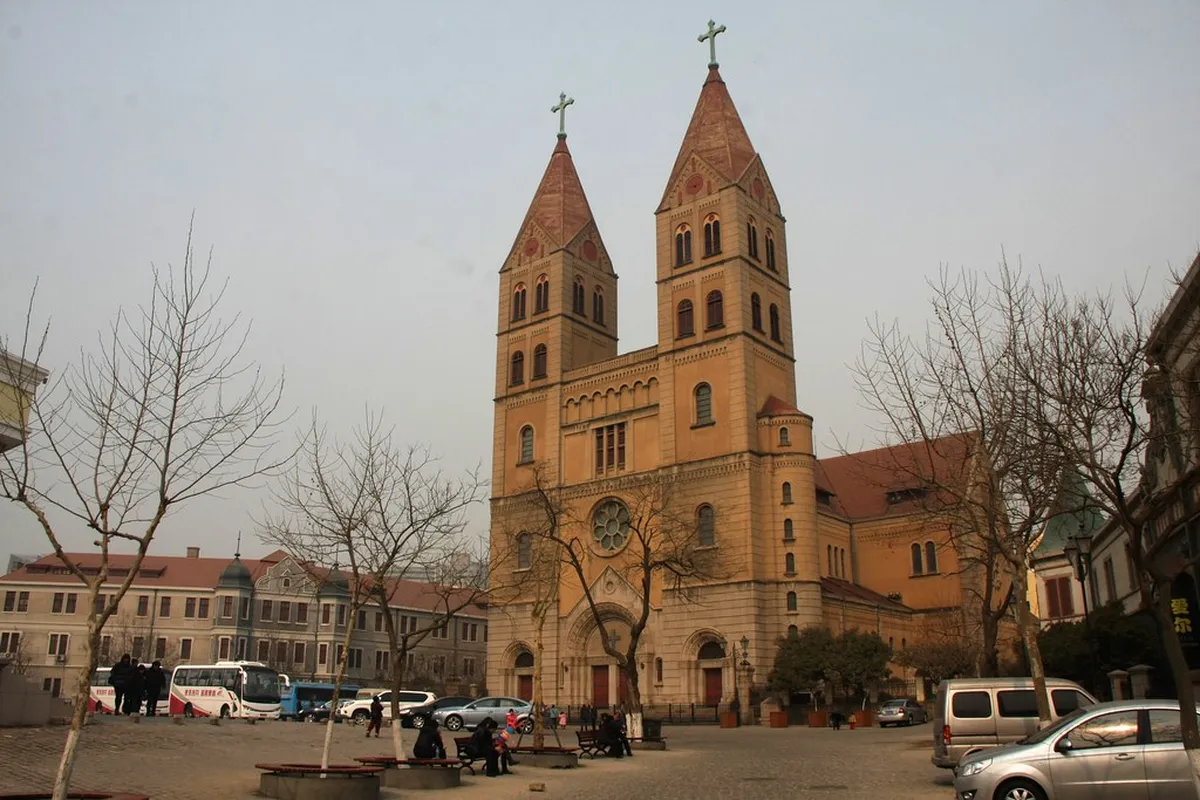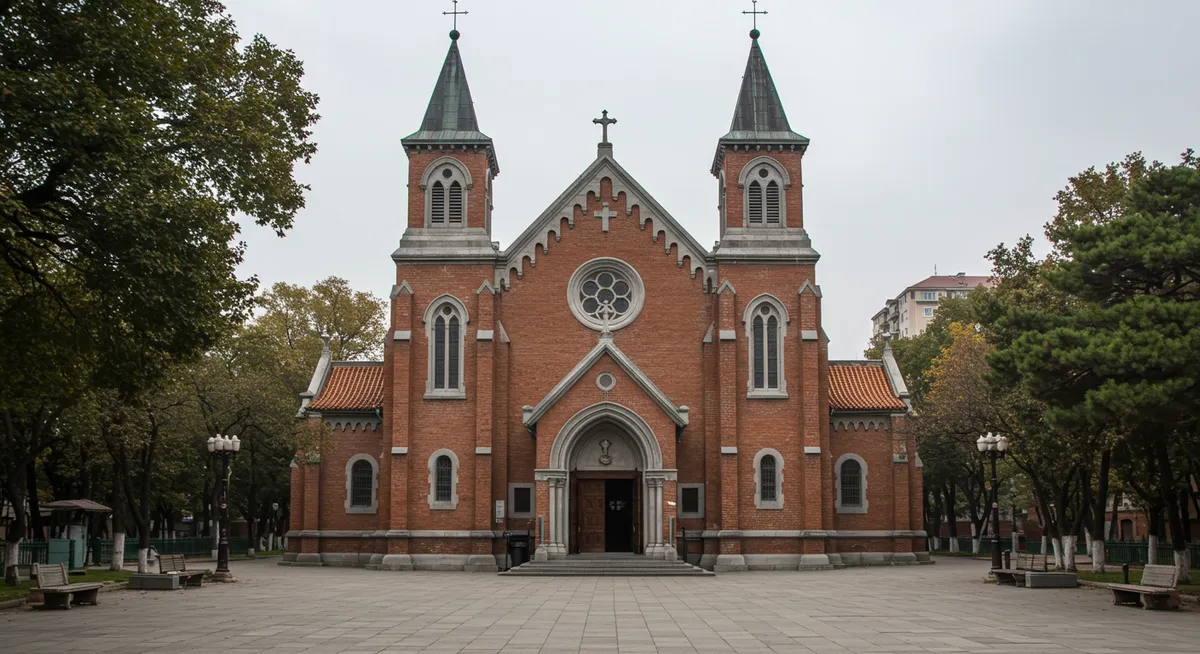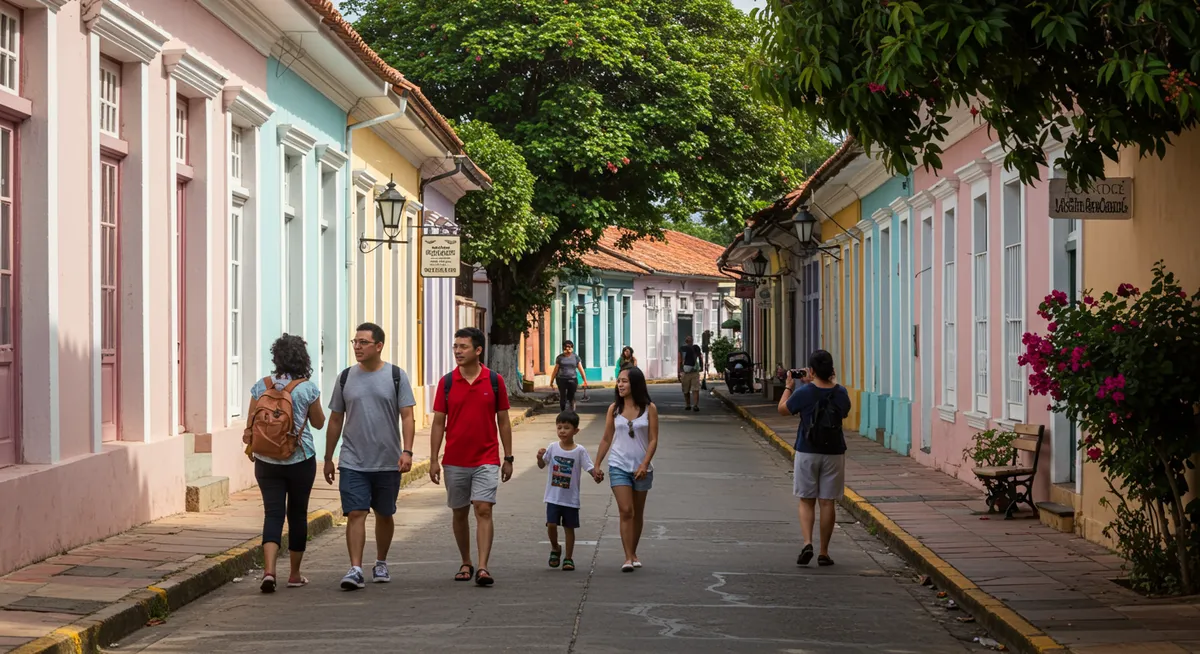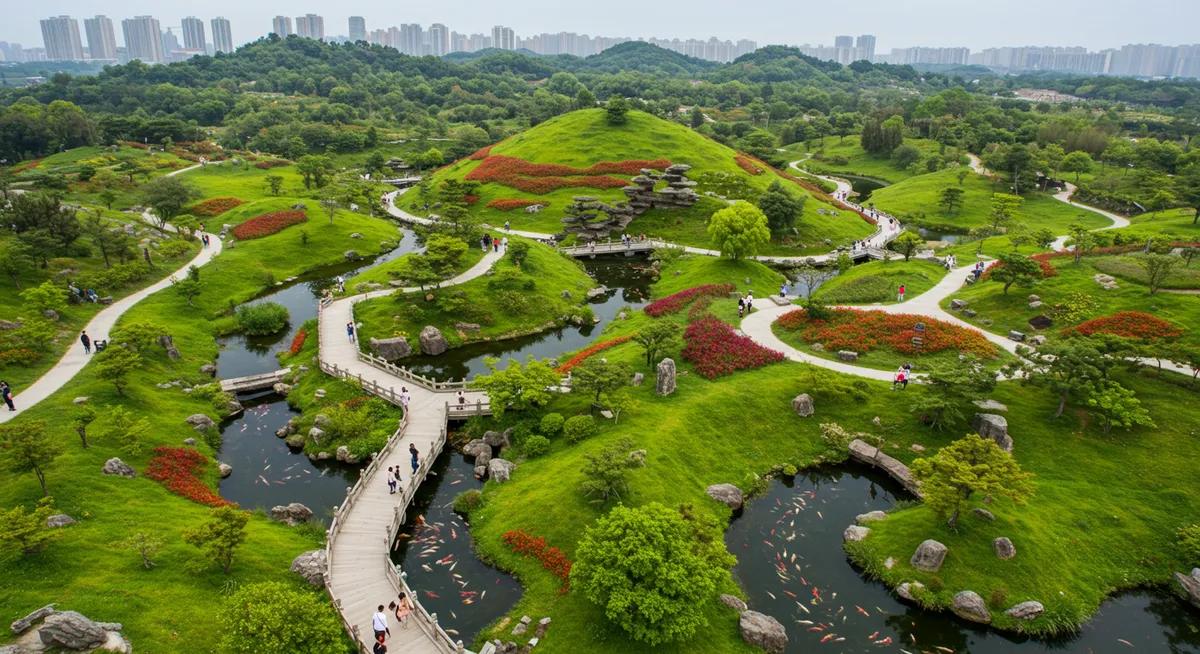Protestant Church Qingdao: Lutheran Heritage & Neo-Romanesque Architecture
Qingdao's Protestant Church stands as a remarkable testament to German Lutheran heritage and Neo-Romanesque architectural excellence, serving both as an active worship center and cultural landmark that represents the enduring Protestant tradition within Qingdao's diverse religious landscape. This comprehensive guide explores the church's distinctive architecture, Lutheran heritage, active community life, and historical significance within the broader context of German colonial influence and modern Chinese religious freedom. Whether drawn by architectural interest, religious heritage, or cultural exploration, the Protestant Church offers meaningful experiences that illuminate the continuing role of Protestant Christianity in contemporary Qingdao while preserving important connections to the city's international past and multicultural present.

Church Overview and Historical Significance
Plan this trip faster with our free online itinerary maker. Get a personalized day-by-day plan in minutes.
Built in 1910 during the German colonial period, the Protestant Church was designed to serve the Lutheran community while establishing a distinctive architectural presence that would complement rather than compete with the later-built Catholic cathedral. The church's Neo-Romanesque style reflects German Protestant architectural traditions adapted for Chinese climatic conditions and local materials.
The church's location within the historic German quarter creates an integrated architectural environment where religious buildings enhance the overall cultural landscape while serving active congregational needs. Its preservation and continued use demonstrate successful adaptation of colonial-era religious architecture for contemporary community purposes.
Today, the Protestant Church continues its original mission while welcoming visitors who appreciate its architectural significance and cultural heritage. This dual role as active worship center and historical monument creates dynamic environments where spiritual life and cultural education intersect meaningfully.
Neo-Romanesque Architecture
Architectural Style and Design Principles
Neo-Romanesque Characteristics:
- Round Arches: Distinctive semicircular arches throughout exterior and interior design
- Solid Masonry: Robust stone construction demonstrating Romanesque engineering principles
- Bell Tower: Prominent tower with Romanesque proportions and details
- Horizontal Emphasis: Lower profile compared to Gothic Revival vertical emphasis
- Symmetrical Composition: Balanced facade design with central entrance focus
- Decorative Elements: Restrained ornamentation appropriate to Protestant traditions
German Protestant Design Adaptations:
- Simplified Decoration: Protestant emphasis on simplicity over elaborate ornamentation
- Functional Layout: Interior designed for Protestant worship practices
- Natural Materials: Local stone and traditional building materials
- Climate Adaptation: Design modifications for Qingdao's coastal climate
- Cultural Sensitivity: Architectural elements respecting Chinese aesthetic preferences
- Engineering Solutions: Modern construction techniques within traditional style
Construction Materials and Techniques
Building Materials:
- Local Granite: Qingdao granite providing structural strength and weather resistance Get deeper into qingdao via Qingdao Festivals.
- German Engineering: Advanced construction techniques ensuring long-term stability
- Traditional Roofing: Clay tile roofing appropriate to German architectural traditions
- Window Materials: High-quality window construction for climate protection
- Interior Materials: Wood and stone interior finishes creating appropriate worship atmosphere
- Restoration Materials: Conservation using period-appropriate materials and methods
Interior Design and Worship Spaces
Protestant Worship Environment
Sanctuary and Nave:
- Central Pulpit: Prominent pulpit reflecting Protestant emphasis on preaching
- Simple Altar: Unadorned altar appropriate to Protestant liturgical practices
- Congregational Seating: Pew arrangement facilitating congregational participation
- Natural Light: Window placement creating bright, welcoming worship environment
- Acoustic Design: Interior designed for clear speech and congregational singing
- Modest Decoration: Restrained decorative elements supporting worship focus
Functional Spaces:
- Fellowship Hall: Community gathering space for social and educational activities
- Church Office: Administrative spaces supporting congregational activities
- Sunday School Rooms: Educational spaces for children and adult programs
- Storage Areas: Practical spaces for church equipment and supplies
- Music Area: Space for choir and musical instruments
- Accessibility Features: Modern accommodations for visitors with mobility needs
Protestant Worship Traditions
Lutheran Heritage and Practices:
- Scripture Focus: Emphasis on Bible reading and biblical preaching
- Congregational Singing: Strong tradition of hymn singing and musical participation
- Liturgical Elements: Lutheran liturgical traditions adapted for Chinese context
- Sacramental Practice: Communion and baptism following Lutheran traditions
- Educational Emphasis: Strong focus on religious education and Bible study
- Community Fellowship: Social activities strengthening congregational bonds
Religious Life and Community
🎯 Insider Tip: Discover the best Lutheran experiences with Viator Tours!
Active Congregation and Services
Regular Worship Services:
- Sunday Services: Main weekly worship services for congregation
- Weekday Programs: Bible study and prayer meetings throughout week
- Special Services: Christmas, Easter, and other seasonal celebrations
- Life Events: Baptisms, confirmations, weddings, and memorial services
- Language Options: Services primarily in Chinese with some multilingual elements
- Youth Ministry: Programs for children and young adults
Community Outreach and Activities:
- Social Services: Community service and charitable work
- Educational Programs: Religious education for all ages
- Cultural Events: Community festivals and celebration activities
- International Ministry: Programs serving international Protestant community
- Interfaith Relations: Cooperation with other religious communities
- Charitable Works: Community support and assistance programs
Protestant Heritage and Identity
German Lutheran Legacy:
- Historical Continuity: Maintaining connection to German Protestant traditions
- Cultural Bridge: Link between German heritage and Chinese Protestant community
- Theological Emphasis: Lutheran theological principles in Chinese context
- Musical Traditions: German Protestant hymn traditions adapted for Chinese worship
- Educational Heritage: Strong Protestant emphasis on education and literacy
- International Connection: Links with global Protestant and Lutheran communities
Historical Development and Context
German Colonial Period and Foundation
Early Protestant Mission:
- Mission History: Early German Protestant missionaries in Qingdao region
- Community Growth: Expanding Protestant community requiring permanent church
- Colonial Support: German administration supporting Protestant church construction
- Architectural Planning: Design process and architectural decision-making
- Construction Period: Building process and community involvement
- Dedication and Opening: Church consecration and early community life
20th Century Challenges and Adaptation:
- Japanese Period: Changes in administration and community leadership
- Chinese Civil War: Challenges to religious institutions and community
- Cultural Revolution: Period of restricted religious activity
- Religious Freedom Restoration: Renewal of religious freedom and community growth
- Modern Development: Contemporary community programs and outreach
- Heritage Preservation: Protection as historical and cultural monument
Protestant Christianity in Modern Qingdao
Contemporary Religious Life:
- Religious Freedom: Current status of Protestant Christianity in China
- Community Growth: Expanding Protestant community in modern Qingdao
- Cultural Integration: Protestant traditions within Chinese cultural context
- Educational Contributions: Protestant emphasis on education and social development
- International Relations: Connections with global Protestant communities
- Social Contributions: Protestant community involvement in social welfare
Visitor Experience and Cultural Education
Visitor Guidelines and Etiquette
Respectful Visiting Practices:
- Quiet Reverence: Maintain respectful behavior throughout church visit
- Service Observation: Visitors welcome to observe worship services respectfully
- Photography Guidelines: Check with church staff before photographing interior
- Dress Appropriately: Modest clothing suitable for religious environment
- Cultural Sensitivity: Understanding Protestant traditions and customs
- Community Respect: Honor ongoing religious activities and community life
Educational Opportunities:
- Architectural Education: Information about Neo-Romanesque design and Protestant architecture
- Religious Understanding: Learning about Protestant traditions and Lutheran heritage
- Historical Context: Understanding German colonial period and religious development
- Cultural Exchange: Protestant contribution to Qingdao's multicultural character
- Interfaith Dialogue: Comparison with other religious traditions in Qingdao
- Heritage Appreciation: Understanding preservation of religious architecture
Architecture Comparison and Analysis
💡 Pro Tip: Book your Lutheran adventures in advance through Viator for the best deals!
Protestant vs. Catholic Architecture
Architectural Philosophy Differences:
- Protestant Simplicity: Simpler decoration compared to Catholic elaborate ornamentation
- Functional Emphasis: Design prioritizing worship function over artistic display
- Scale Differences: More intimate scale compared to cathedral monumentality
- Theological Expression: Architecture reflecting Protestant theological principles
- Community Focus: Design emphasizing congregational participation
- Cultural Adaptation: Protestant traditions adapted for Chinese cultural context
Complementary Roles in Religious Landscape:
- Religious Diversity: Protestant church contributing to Qingdao's religious pluralism
- Architectural Variety: Different architectural styles enriching urban landscape
- Historical Narrative: Both churches representing German colonial religious heritage
- Community Service: Different approaches to community engagement and service
- Cultural Bridge: Both churches connecting international and Chinese communities
- Heritage Value: Combined contribution to Qingdao's architectural heritage
Photography and Documentation
Architectural Photography
Exterior Photography Opportunities:
- Facade Details: Neo-Romanesque architectural elements and decoration
- Bell Tower: Distinctive tower architecture and proportions
- Context Shots: Church within historic German architectural district
- Seasonal Variations: Different lighting and weather conditions
- Architectural Details: Stone work, windows, and construction elements
- Comparative Studies: Comparison with other religious architecture
Photography Guidelines and Restrictions:
- Permission Required: Check with church administration before interior photography
- Service Restrictions: No photography during religious services
- Respectful Approach: Non-intrusive photography respecting worship environment
- Flash Restrictions: Avoid flash photography that might disturb activities
- Cultural Sensitivity: Respectful documentation of religious space
- Community Privacy: Respect congregation privacy during worship
Practical Information and Access
Location and Transportation
Access Information:
- Historic District Location: Within walking distance of major historic attractions
- Public Transportation: Accessible via multiple bus routes and metro connections
- Walking Routes: Easy walking connections to other religious and cultural sites
- Taxi Access: Direct taxi service to church area
- Pedestrian Safety: Safe walking routes through historic neighborhood
- Accessibility: Ground-level access suitable for most mobility needs
For comprehensive transportation options, consult our detailed transport guide.
Visiting Hours and Availability:
- Service Times: Check current schedule for worship service times
- Open Hours: Generally accessible during daylight hours for visitors
- Special Events: Extended hours during religious celebrations
- Group Visits: Advance arrangement recommended for large groups
- Guided Tours: Available by appointment with church administration
- Language Support: Basic English information available for international visitors
Cultural Events and Special Programs
⭐ Recommendation: Don't miss out on amazing Lutheran tours - book now!
Religious Calendar and Celebrations
Protestant Religious Observances:
- Christmas Services: Special Christmas Eve and Christmas Day celebrations
- Easter Celebration: Holy Week and Easter Sunday services
- Reformation Sunday: Annual celebration of Protestant Reformation heritage
- Harvest Festival: Thanksgiving and harvest celebration services
- Confirmation Services: Annual confirmation ceremonies for young members
- Special Occasions: Baptisms, weddings, and memorial services
Community and Cultural Events:
- Music Programs: Concerts and musical presentations
- Educational Events: Lectures and cultural education programs
- Community Service: Charitable activities and community outreach
- Interfaith Activities: Programs promoting religious understanding
- Cultural Festivals: Celebration of German and Chinese cultural heritage
- Youth Programs: Activities for children and young adults
Combining with Other Qingdao Attractions
⭐ Recommendation: Don't miss out on amazing Lutheran tours - book now!
Religious Heritage Tour
Multi-Religious Exploration:
- Catholic-Protestant Comparison: Protestant Church + St. Michael's Cathedral
- Religious Architecture: Different architectural approaches to sacred space
- Theological Differences: Understanding Protestant and Catholic traditions
- Cultural Integration: Both traditions within Chinese cultural context
- Historical Development: Religious communities during German colonial period
- Modern Adaptation: Contemporary religious life in modern China
Historic District Integration:
- German Architecture Tour: Protestant Church + Little Fish Hill + colonial buildings
- Cultural Heritage Walk: Religious sites + Badaguan architecture
- Historic Center Tour: Church + Signal Hill + viewpoints
- Photography Circuit: Multiple architectural styles and periods
- Educational Journey: Religious heritage + colonial history + modern development
Educational Value and Cultural Significance
Protestant Heritage Education
Religious and Cultural Education:
- Protestant Principles: Understanding Lutheran and Protestant theological principles
- Religious Freedom: History of religious freedom and tolerance in China
- Cultural Exchange: Protestant contributions to Chinese education and social development
- International Heritage: German Protestant missions and cultural influence
- Modern Adaptation: Contemporary Protestant life in Chinese cultural context
- Interfaith Understanding: Protestant church within Qingdao's religious diversity
Architectural and Historical Education
Design and Construction Education:
- Neo-Romanesque Style: Understanding architectural movement and characteristics
- German Engineering: Construction techniques and engineering principles
- Cultural Adaptation: European architecture adapted for Chinese conditions
- Preservation Science: Conservation techniques for historic religious buildings
- Urban Planning: Religious buildings within colonial city planning
- Heritage Value: Cultural significance of religious architectural heritage
The Protestant Church provides essential balance to Qingdao's religious architectural heritage, demonstrating how different Christian traditions created distinct but complementary sacred spaces within the historic German quarter. Its continuing role as active worship center while serving as cultural monument exemplifies successful heritage preservation that honors both historical significance and contemporary community needs.
Include Protestant Church visits in comprehensive Qingdao exploration using our detailed itineraries, and discover how this Neo-Romanesque landmark contributes to understanding the religious diversity and cultural tolerance that define modern Qingdao's character as an international coastal city with deep respect for its multicultural heritage. Keep exploring Qingdao: Qingdao festival guide.



